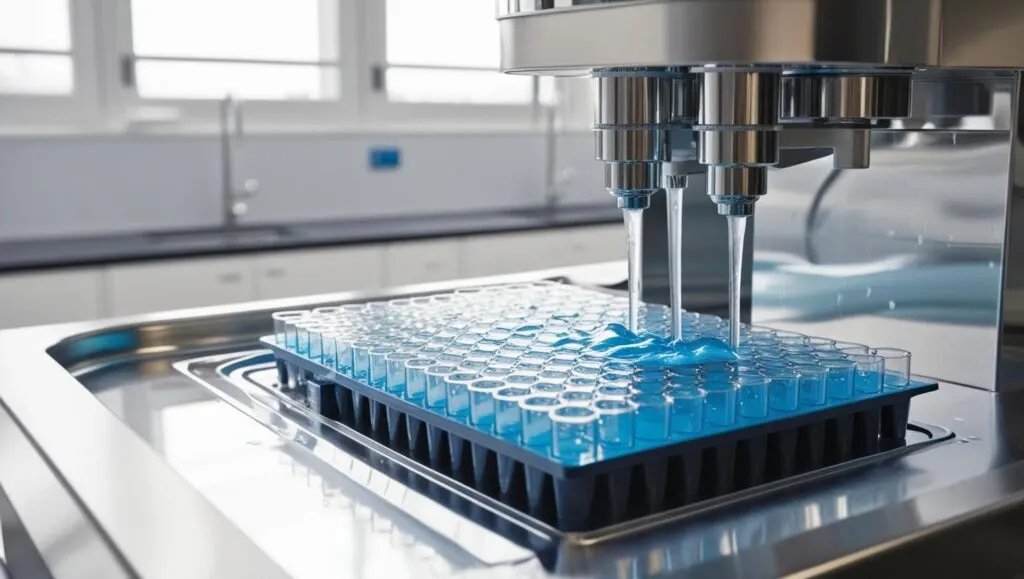In modern laboratory environments, efficiency and accuracy are crucial. A microplate washer is an essential piece of laboratory equipment designed to automate the washing of microplates used in various biochemical and diagnostic assays. These devices remove unbound reagents, reducing background noise and ensuring consistent results.
As a leading supplier of laboratory equipment in South Africa, Apex Scientific offers a microplate washer to meet diverse research and clinical needs. Browse our models here. One of our key partners, Allsheng, provides high-quality, precision-engineered models designed for high-throughput workflows.
Manually washing microplates can be tedious and inconsistent. A microplate washer enhances efficiency and reliability in laboratories by offering:
- Time Efficiency – Automates the washing process, saving valuable time.
- Consistency and Accuracy – Ensures reproducible results across multiple assays.
- Automation – Reduces human error, improving workflow efficiency.
- Reduced Contamination Risk – Minimizes cross-contamination associated with manual washing.
Key Technical Specifications to Consider
- Washing Modes – Options include single, multi, or sequential washes for different assay requirements.
- Wash Volume and Pressure – Adjustable settings ensure optimal cleaning for specific applications.
- Plate Compatibility – Some models support 96-well and 384-well plates, making them versatile for different assays.
- Buffer Compatibility – The ability to handle various buffers prevents corrosion or clogging.
- Washing Speed – Faster cycle times are beneficial for high-throughput laboratories.
Applications
- ELISA (Enzyme-Linked Immunosorbent Assays) – Removes excess substrates and enzymes for accurate optical readings.
- Protein Assays – Ensures optimal removal of unbound reagents in biochemical studies.
- Cell Culture – Supports washing steps in cell-based assays, reducing interference from residual reagents.
For laboratories specializing in immunology, microbiology, or pharmaceutical research, a high-quality microplate washer is a critical component of their workflow.
Choosing the Right Instrument
When selecting a microplate washer, consider:
- Throughput Requirements – Laboratories processing high sample volumes require a model with faster cycle times.
- Assay Type – Different assays demand specific wash volumes and pressures for optimal performance.
- Ease of Use and Maintenance – Models with intuitive interfaces and easy-to-clean components simplify operation.
Microplate Washer Accessories
- Additional Wash Heads – Customizable wash heads optimize efficiency for specific assays.
- Adapters and Plates – Ensures compatibility with various microplate formats.
- Software Integration – Allows automated tracking of wash cycles and assay results for improved workflow management.
Comparing Models
Different microplate washer models vary in terms of speed, precision, and automation levels. High-end models feature:
- Advanced fluidics for improved wash efficiency
- Programmable settings for custom protocols
- Compact designs suitable for space-constrained laboratories
Leading brands such as Allsheng offer robust microplate washers engineered for demanding laboratory environments.
Maintenance and Calibration
Proper maintenance ensures long-term reliability of a microplate washer. Routine tasks include:
- Cleaning and Decontamination – Prevents reagent buildup and cross-contamination.
- Leak Checks – Ensures consistent fluid dispensing.
- Calibration – Maintains accuracy in wash cycles, preventing errors in assay results
Regular servicing extends the lifespan of a microplate washer, reducing downtime and operational costs.
Conclusion
Choosing the best microplate washer requires careful evaluation of throughput needs, assay requirements, and budget. Investing in a high-quality model improves lab efficiency, accuracy, and reproducibility.
For expert guidance on selecting the ideal microplate washer, explore Apex Scientific’s laboratory equipment range or contact us today.




